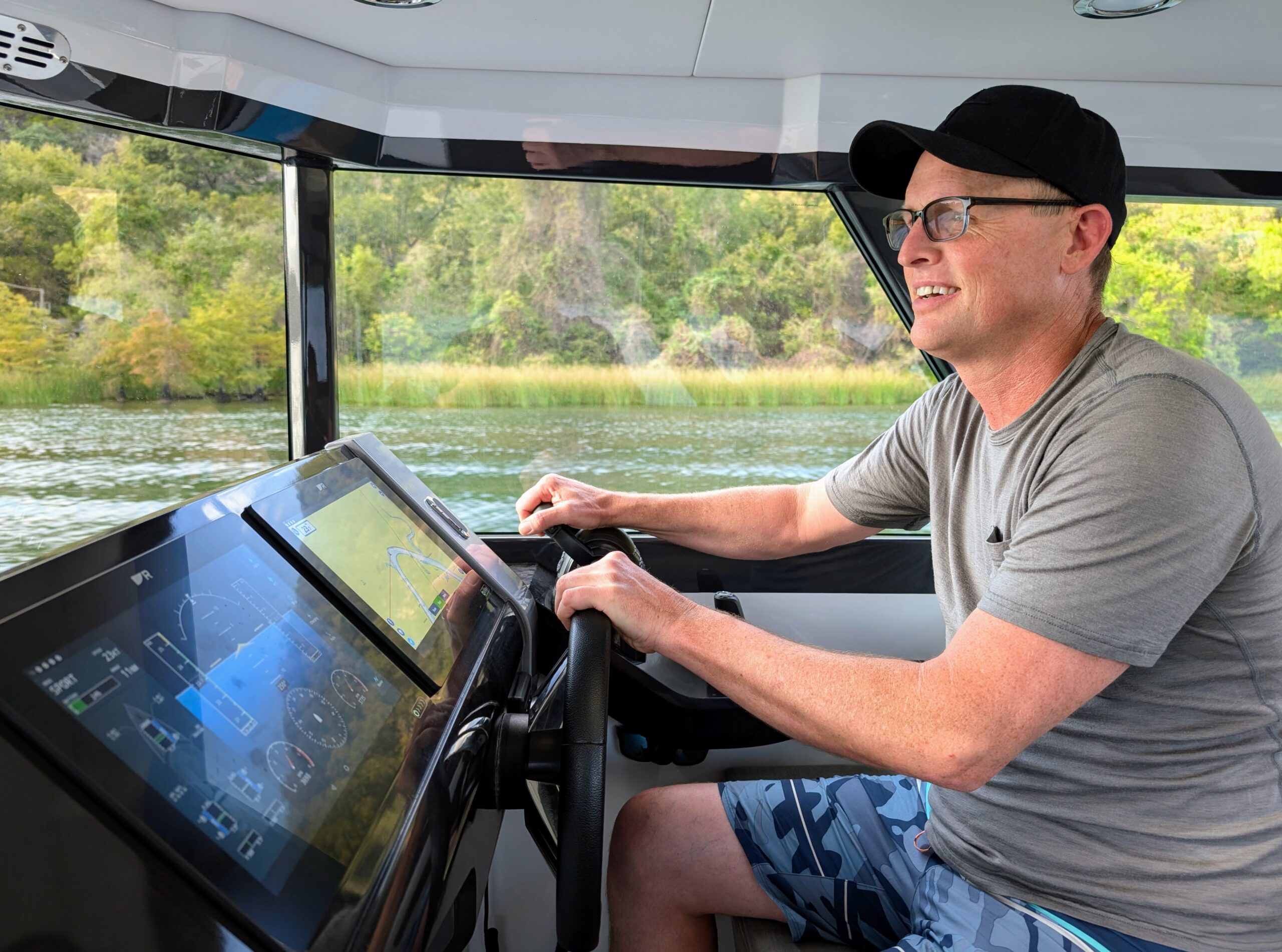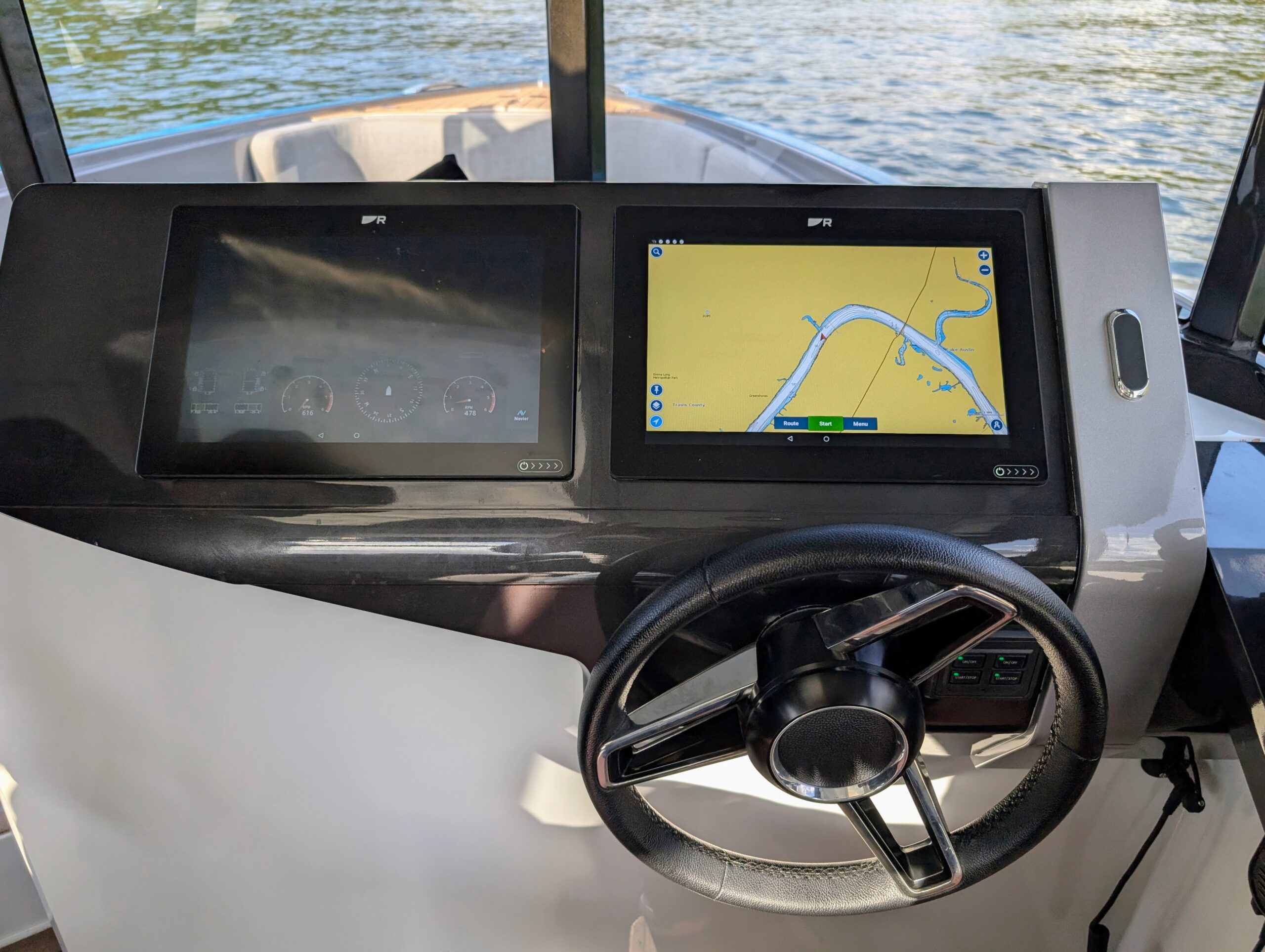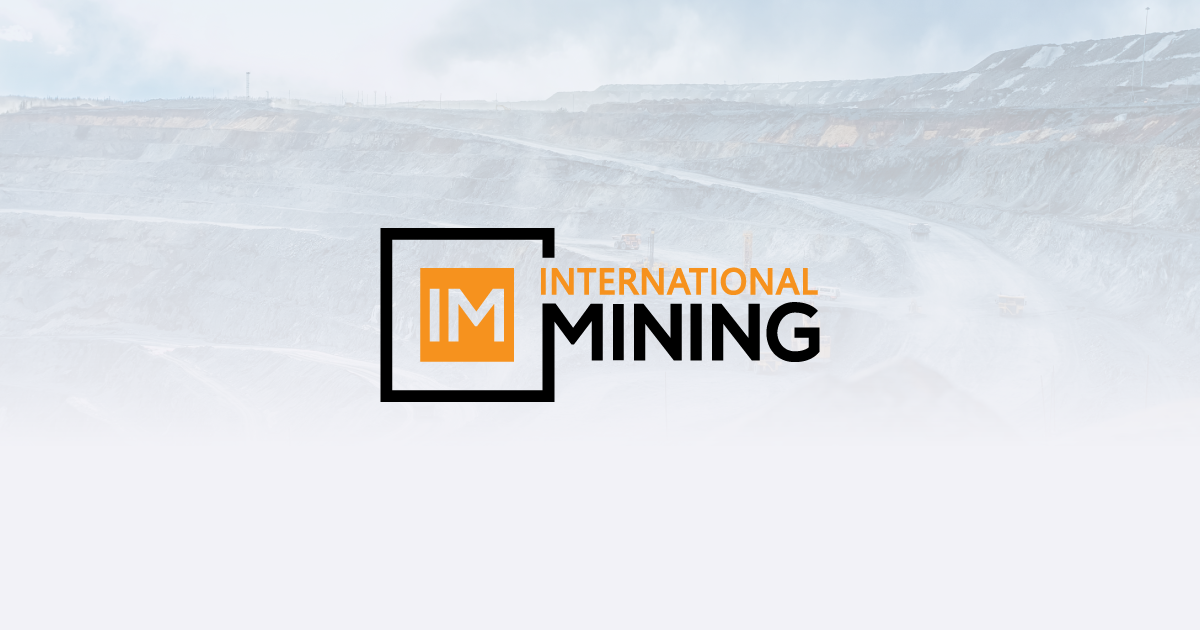Sign up for daily news updates from CleanTechnica on email. Or follow us on Google News!
Electrifying boats is no small challenge, but thanks to years of consistent advancements in electric motors, onboard control systems paired with hydrofoil technology stemming from the America’s Cup racing series and more, the dream is coming closer to reality. One company pushing the envelope in that space is Navier Boats.
I started keeping an eye on them earlier this year and was excited when an opportunity popped up on a recent trip to spend some time on a prototype build of the Navier N30 and spend some time talking with a few of their team members. Kris & Sophia were gracious enough to show us around the N30 and to take us for a ride and even let us take the controls for a bit to get a feeling for their production-intent boat.
Navier developed the prototype we experienced in under 2 years. That’s the whole enchilada — from concept to reality. Perhaps more impressive, in that same amount of time they also secured dozens of orders and delivered the first production boat to a customer.

All that is to say, the Navier N30 is very real, delivers meaningful performance, and is on the fast track to production in meaningful quantities. With a backlog of over 50 orders and a price tag starting in the $600,000 range, they aren’t cheap, but new technology rarely is.
What sets Navier’s boats apart is that they were designed by a team largely comprised of aerospace engineers and thus adopted the popular aileron configuration for trio of underwater hydrofoils. The wing up front is responsible for keeping the boat up out of the water and controls pitch and thus the height of the boat in the water.
The two rear foils serve more as the flaps of an airplane and give it the ability to maneuver in the water. The N30’s onboard flight control system takes care of bringing the hull up out of the water and up onto the hydrofoils when the boat reaches a speed of 16 knots. At that speed, enough water is moving past the wing to give it the ability to control the height of the boat in a stable manner.

The onboard control system does all of the balancing from that point forward, translating steering inputs from the steering wheel in the cockpit into agile movements through the water.
What’s so impressive about hydrofoil boats, including Navier’s boat, is when you’re up on the foils, it’s literally slicing through the water, leaving essentially no wake behind it regardless of the speed. The two electric outboard motors behind the vehicle offer a ton of power and control, but don’t leave any sort of meaningful wake behind.
To demonstrate the agility of the boat, Kris whipped a U-turn without throttling down. The boat’s control system kept the boat and passengers stable through the turn as we made a graceful arc through the water in a much tighter radius than I would have expected. At the same time, the experience in the boat was extremely stable and didn’t rock the boat in any meaningful way.
This is thanks to the fact that the boat is riding 4 feet out of the water with only the hydrofoils touching the water. The wings under the water are quite literally doing the heavy lifting of keeping the boat aloft, which means there are no jarring motions from cutting over the wake from other boats or any other surface disturbances.
Later on in the flight we performed an S-turn through a series of ski boats and it felt like we were essentially dancing through the boats. The blades kept us flying up over the surface, leaving no wake to disturb the other boats as we passed.
Navier’s design is different from its competitor Candela in that Navier opted for a pair of 90 kW outboard motors that have their own independent controls. These sit out back of the boat instead of the foil-mounted motors used in Candela’s design.
Using two independently controlled outboards gives Navier an advantage in that it can use the onboard GPS to create a virtual anchor. This function utilizes the dual motors to countersteer, locking the boat into a single physical position. It uses GPS and some impressive coordination to do this, and in our testing, it felt like magic.
It was surprisingly effective and seems like it would be a great option for deep lakes or even for maintaining a set position far out into the ocean where an anchor would be effectively useless. The Navier team used this while waiting for me to get ready and it looked so strange to see the boat virtually “anchored” in place under the bridge as water flowed around it.

The ability to independently control the two rear motors is also useful when docking. In addition to the traditional boat throttle lever, the N30 has a small joystick that can move front to back, calling on the motors to more accurately propel the boat forward and back. This joystick is perfect for making minute adjustments when docking, but it also has a few tricks up its sleeve.
The joystick also packs a little secret, in that it can be twisted to literally spin the boat on a single axis to again allow it to navigate into the exact position needed for docking, pulling up next to another boat which we did on our trip, or any other use case you could imagine. It can also propel the boat laterally to the left or right. It feels like it shouldn’t be possible, but feeling it work just feels right.

The N30 prototype we looked at was equipped with a 114 kWh battery pack, and it can also be configured with an 85 kWh pack if desired. The 114 kWh pack translates to a range of up to 75 nautical miles at 20 knots, though this will vary depending on how you drive it, water conditions, etc.
When it comes time to charge, Navier’s boat can use the standard Marine fast charging units, a mobile Tesla charging unit, or the typical 50 amp / 240 volt shore power options available in most harbors around the world.
With all the technology packed in the Navier boats, they clearly aren’t cheap, but you wouldn’t expect them to be. What sets Navier apart in my mind is the speed to prototype, and perhaps more importantly than that, the speed to their first sellable product.

Customers can configure all of the usual options, from the fabric on the seats to the exterior color and the cabin configuration. This includes a closed-off cabin with sliding doors or a t-top configuration with a shade awning over the top. The N30 is a premium boat for premium customers, whether they be high net worth individuals, luxury hotels, or even shuttle services looking to silently move people back and forth with zero emissions.
The experience was amazing, and I would highly encourage anyone interested in these types of boats, whether it be just to be informed about their cutting edge technologies or to purchase one, head over to the Navier Boat website, follow them on their social channels, and to reach out to their team.
This is not a sponsored post, we just think Navier Boat has done some amazing engineering to develop a cutting edge, clean tech product that is really set to change the world starting with a line of high end recreational boats. Beyond that though, the future is bright as the market for larger and increasingly impactful vessels like multi-person shuttles, ferries, and even cargo vessels is all ripe for disruption at home and abroad.
Chip in a few dollars a month to help support independent cleantech coverage that helps to accelerate the cleantech revolution!
Have a tip for CleanTechnica? Want to advertise? Want to suggest a guest for our CleanTech Talk podcast? Contact us here.
Sign up for our daily newsletter for 15 new cleantech stories a day. Or sign up for our weekly one if daily is too frequent.
CleanTechnica uses affiliate links. See our policy here.
CleanTechnica’s Comment Policy





